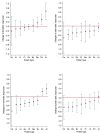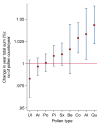Pollen Season Trends (1973-2013) in Stockholm Area, Sweden
- PMID: 27898718
- PMCID: PMC5127655
- DOI: 10.1371/journal.pone.0166887
Pollen Season Trends (1973-2013) in Stockholm Area, Sweden
Abstract
In the present study, the phenological and quantitative changes in the pollen seasons between 1973 and 2013 in the Stockholm region of Sweden were studied for nine types of pollen (hazel, alder, elm, birch, oak, grass, mugwort, willow and pine). Linear regression models were used to estimate the long term trends in duration, start- and end-dates, peak-values and the yearly accumulated pollen sums of the pollen seasons. The pollen seasons of several arboreal plant species (e.g. birch, oak and pine) were found to start significantly earlier today compared to 41 years earlier, and have an earlier peak-date, while the season of other species seemed largely unaffected. However, the long term trends in the end-dates of pollen seasons differed between arboreal and herbaceous species. For herbaceous species (grass and mugwort), a significant change towards later end-dates was observed and the duration of season was found to have increased. A significant trend towards an earlier end-date was found in the majority of the arboreal plant species (i.e. elm, oak, pine and birch), but the length of the season seemed unaffected. A trend towards an increase in yearly concentrations of pollen was observed for several species; however the reasons for this phenomenon cannot be explained unambiguously by the present study design. The trend of increasing yearly mean air temperatures in the Stockholm area may be the reason to changed phenological patterns of pollen seasons.
Conflict of interest statement
The authors have declared that no competing interests exist
Figures



Similar articles
-
Statistical approach to the analysis of olive long-term pollen season trends in southern Spain.Sci Total Environ. 2014 Mar 1;473-474:103-9. doi: 10.1016/j.scitotenv.2013.11.142. Epub 2013 Dec 20. Sci Total Environ. 2014. PMID: 24361781
-
The dynamics of pollen seasons of the most allergenic plants - 15-year observations in Warsaw.Otolaryngol Pol. 2018 Sep 10;72(6):44-53. doi: 10.5604/01.3001.0012.4664. Otolaryngol Pol. 2018. PMID: 30647196
-
The impact of weather and climate on pollen concentrations in Denver, Colorado, 2010-2018.Ann Allergy Asthma Immunol. 2019 Nov;123(5):494-502.e4. doi: 10.1016/j.anai.2019.08.002. Epub 2019 Aug 8. Ann Allergy Asthma Immunol. 2019. PMID: 31401104
-
[Outdoor aeroallergens and climate change].Rev Mal Respir. 2021 Dec;38(10):1025-1036. doi: 10.1016/j.rmr.2021.08.007. Epub 2021 Nov 20. Rev Mal Respir. 2021. PMID: 34794844 Review. French.
-
Defining Pollen Seasons: Background and Recommendations.Curr Allergy Asthma Rep. 2018 Oct 29;18(12):73. doi: 10.1007/s11882-018-0829-z. Curr Allergy Asthma Rep. 2018. PMID: 30374908 Free PMC article. Review.
Cited by
-
Medium-Term Increases in Ambient Grass Pollen Between 1994-1999 and 2016-2020 in a Subtropical Climate Zone.Front Allergy. 2021 Aug 5;2:705313. doi: 10.3389/falgy.2021.705313. eCollection 2021. Front Allergy. 2021. PMID: 35387005 Free PMC article.
-
Long-Term Pollen Monitoring in the Benelux: Evaluation of Allergenic Pollen Levels and Temporal Variations of Pollen Seasons.Front Allergy. 2021 Jul 8;2:676176. doi: 10.3389/falgy.2021.676176. eCollection 2021. Front Allergy. 2021. PMID: 35387026 Free PMC article.
-
Association between climate indicators and hay fever incidence in children and adolescents in Freiburg, Germany.Front Public Health. 2025 Jun 4;13:1587767. doi: 10.3389/fpubh.2025.1587767. eCollection 2025. Front Public Health. 2025. PMID: 40535446 Free PMC article.
-
Respiratory allergies: Salicaceae sensitization (Review).Exp Ther Med. 2021 Jun;21(6):609. doi: 10.3892/etm.2021.10041. Epub 2021 Apr 14. Exp Ther Med. 2021. PMID: 33936266 Free PMC article. Review.
-
Clustering approach for the analysis of the fluorescent bioaerosol collected by an automatic detector.PLoS One. 2021 Mar 11;16(3):e0247284. doi: 10.1371/journal.pone.0247284. eCollection 2021. PLoS One. 2021. PMID: 33705418 Free PMC article.
References
-
- Stocker TF, Qin D, Plattner G-K, Tignor M, Allen SK, Boschung J, et al. (2013) Climate Change 2013. The Physical Science Basis. Working Group I Contribution to the Fifth Assessment Report of the Intergovernmental Panel on Climate Change-Abstract for decision-makers. Groupe d'experts intergouvernemental sur l'evolution du climat/Intergovernmental Panel on Climate Change-IPCC, C/O World Meteorological Organization, 7bis Avenue de la Paix, CP 2300 CH-1211 Geneva 2 (Switzerland).
-
- Karlsen SR, Hogda KA, Wielgolaski FE, Tolvanen A, Tommervik H, Poikolainen J, et al. (2009) Growing-season trends in Fennoscandia 1982–2006, determined from satellite and phenology data. Climate Research 39: 275–286.
-
- van Vliet AJH, Overeem A, De Groot RS, Jacobs AFG, Spieksma FTM (2002) The influence of temperature and climate change on the timing of pollen release in the Netherlands. International Journal of Climatology 22: 1757–1767.
-
- Bonofiglio T, Orlandi F, Ruga L, Romano B, Fornaciari M (2013) Climate change impact on the olive pollen season in Mediterranean areas of Italy: air quality in late spring from an allergenic point of view. Environmental Monitoring and Assessment 185: 877–890. 10.1007/s10661-012-2598-9 - DOI - PubMed
MeSH terms
Substances
LinkOut - more resources
Full Text Sources
Other Literature Sources

